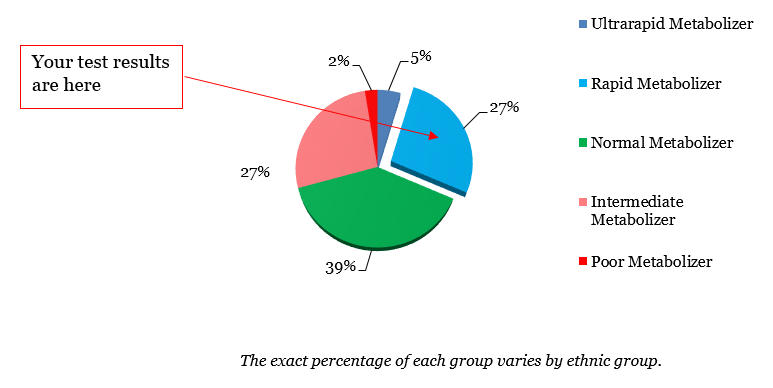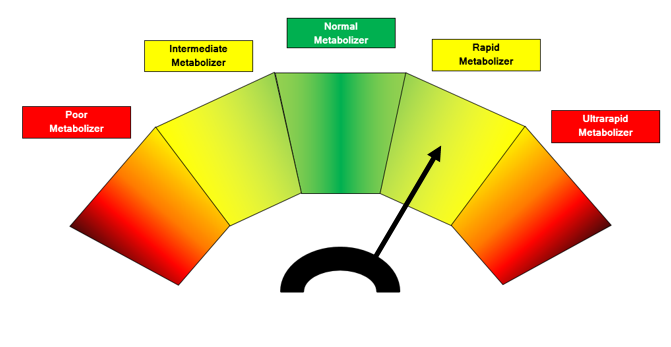Cytochrome P450 2C19 (CYP2C19) Rapid Metabolizer
When you take a medicine, your body needs to process the medicine. One way to process the medicine is for enzymes (proteins in the body) to change or break down the medicine. An enzyme called cytochrome P450 2C19 (CYP2C19 “Sip – 2 – See – 19”) helps to process some medications including clopidogrel (Plavix®), voriconazole (Vfend®), and many antidepressants. Like many medicines, how well the medicine works and side effects are different from person to person. One of the reasons why this happens is because of differences in how well CYP2C19 works in each person.
How does CYP2C19 work?
The CYP2C19 enzyme processes (metabolizes) medicine to remove them from the body. There are many medications that are metabolized by CYP2C19. Some medications such as voriconazole are metabolized to inactive forms that are more easily removed from the body. Other medications, like clopidogrel, need activation by CYP2C19 to be effective.
Many people have CYP2C19 enzyme that works well and have no trouble processing medications. Some people have CYP2C19 enzyme that does not work well (Intermediate and Poor Metabolizers) while others have CYP2C19 enzyme that works better than average (Rapid and Ultrarapid Metabolizers). When people in these groups take normal doses of medications that are metabolized by CYP2C19, they may not see the wanted effect of the medication, experiencing either treatment failure or side effects.
How do my genes affect my response to medications?
Genes, which are made up of DNA, are a set of instructions that act like blueprints and tell our bodies how to grow and work. We have two copies of each gene in every cell of the body, one from our mother and one from our father. The CYP2C19 gene is a set of instructions for making CYP2C19 enzyme. Small changes in the CYP2C19 gene can change how well the CYP2C19 enzyme works to break down medications.
Your healthcare team has ordered a test that looks at your child’s CYP2C19 gene. The test looked for differences in your child’s CYP2C19 gene. These differences predict how well your child’s CYP2C19 enzyme works. The test results will help doctors choose the best doses of medications for your child.
The CYP2C19 gene test results have placed your child into the Rapid Metabolizer (RM) group.

We recommend that you report this information to every doctor, nurse practitioner, other clinicians and the pharmacist where you get your prescriptions filled. A pharmacist at Children’s Minnesota is available for questions regarding these test results. Alternatively, you may contact the pharmacogenomics pharmacist through the patient portal or through the Children’s Minnesota Pharmacogenomics Program at 612-813-7240.

Common Medications Metabolized by CYP2C19
| Medication | Usual Use | Action to be taken in Rapid Metabolizer |
| Clopidogrel (Plavix ®) | Blood thinner | Use standard dose |
| Voriconazole (Vfend®) | Fungal infection | Use standard dose – check drug levels |
| Amitriptyline | Antidepressant | Select alternative drug or standard dose and check drug levels |
| Imipramine | Antidepressant | Select alternative drug or standard dose and check drug levels |
| Clomipramine | Antidepressant | Select alternative drug or standard dose and check drug levels |
| Trimipramine | Antidepressant | Select alternative drug or standard dose and check drug levels |
| Doxepin | Antidepressant | Select alternative drug or standard dose and check drug levels |
| Citalopram (Celexa®) | Antidepressant | Use standard starting dose |
| Escitalopram (Lexapro®) | Antidepressant | Use standard starting dose |
| Sertraline (Zoloft ®) | Antidepressant | Use standard starting dose |
This list is not meant to include all medications affected by CYP2C19. Other medications may be affected by CYP2C19, check with your doctor or pharmacist if you have any questions.
This page is not specific to your child, but provides general information on the topic above. If you have any questions, please call your clinic. For more reading material about this and other health topics, please call or visit Children's Minnesota Family Resource Center library, or visit www.childrensmn.org/educationmaterials.
© 2024 Children's Minnesota
